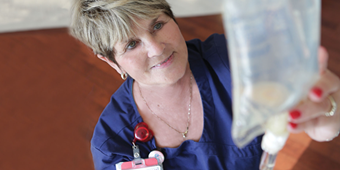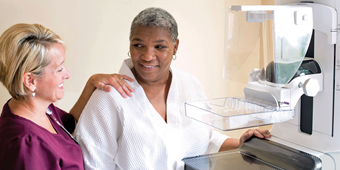The Fundamentals of Bladder Cancer
.jpg?sfvrsn=6a500661_4)
Answer a few questions and we'll provide you with a list of primary care providers that best fit your needs.
You may not hear much about bladder cancer, but it turns out it’s the sixth most common form of cancer in the United States. What should you be on the lookout for with this type of cancer?
Located in the lower abdomen, your bladder is a hollow organ with flexible, muscled walls. Shaped something like a small balloon, it stores liquid waste (urine) made by your kidneys, before passing the urine from your body through the urethra.
The walls of the bladder have several layers: an inner layer called the transitional epithelium or urothelium, a layer of connective tissue including blood vessels and nerves, a layer of muscle, and an outer layer of fatty tissue.
Three types of cancer – the uncontrolled growth of abnormal cells – can arise in the lining of the bladder:
- Transitional cell carcinoma (also known as urothelial carcinoma) starts in the innermost tissue layer of the bladder and is the most common type of bladder cancer. There are “low-grade” and “high-grade” forms of transitional cell carcinoma. Low-grade transitional cell carcinoma rarely spreads into the bladder’s muscle layer or to other parts of the body. High-grade transitional cell carcinoma, on the other hand, often spreads into the muscle layer of the bladder and to other parts of the body, including lymph nodes. Nearly all deaths from bladder cancer are due to high-grade transitional cell carcinoma.
- Squamous cell carcinoma begins in squamous cells — thin, flat cells that line the inside of the bladder.
- Adenocarcinoma begins in glandular cells found in the lining of the bladder. This type of bladder cancer is very rare.
Cancer in the lining of the bladder is called superficial bladder cancer. When cancer spreads through the lining of the bladder and into the bladder’s muscle wall, or beyond that into nearby organs and lymph nodes, it is called invasive bladder cancer.
The Centers for Disease Control and Prevention reports that each year about 56,000 men and 18,000 women get bladder cancer, and about 12,000 men and 5,000 women die from the disease.
 What Are the Symptoms Of Bladder Cancer?
What Are the Symptoms Of Bladder Cancer?
Symptoms of bladder cancer can include:
- Blood in the urine
- Painful urination
- Frequent urination
- Lower back pain
If you experience any of the symptoms of bladder cancer, check with your doctor or health care provider.
Who Is At Risk For Bladder Cancer?
Your chances of developing bladder cancer can increase based on various risk factors, including:
- Tobacco use, especially smoking cigarettes
- Having a family history of bladder cancer
- Exposure to paints, dyes, metals, or petroleum products in the workplace
- Past radiation therapy to the pelvis or treatment with certain anticancer drugs, such as cyclophosphamide or ifosfamide
- Having had cancer before
- Having a birth defect of the bladder
- Taking Aristolochia fangchi, a Chinese herb
- Drinking water with high levels of arsenic
- Drinking water that has been treated with chlorine
- Having a history of bladder infections, including bladder infections caused by Schistosoma haematobium
- Using urinary catheters for a long time
And the chance of getting cancer increases as you get older.
How Is Bladder Cancer Diagnosed?
Finding cancer early, before it’s had time to spread, can improve the chances that treatment will be successful.Since screening tests can be inconclusive and sometimes carry their own risks, screening is not advised for people who are at only average risk for bladder cancer.
But if you are having symptoms, or if you feel you may be at higher risk for bladder cancer, consult your doctor. People at high risk can be tested in a number of ways, including:
- Urinalysis to check for blood in the urine
- Urine cytology — using a microscope to look for cancer cells in the urine
- Newer urine tests that look for certain markers in the urine that could be a sign of bladder cancer
If you are diagnosed with bladder cancer, further tests will be done to determine if the cancer has spread within your bladder and if it has spread to other parts of your body.
Finding cancer early, before it’s had time to spread, can improve the chances that treatment will be successful.
How Is Bladder Cancer Treated?
Treatment varies based on the stage of the cancer (doctors use a four-stage scale to describe the extent to which the disease has spread within the patient’s body) and many other factors. Four types of standard treatment are used:
- Surgery: From removing the cancerous tissue using a thin tool inserted through the urethra, to partial or complete removal of the bladder, or to removal of the bladder and any nearby lymph nodes or organs that contain cancer
- Radiation therapy: Using high-energy x-rays or other kinds of radiation to kill cancer cells or stop them from growing
- Chemotherapy: Using drugs to kill cancer cells or stop them from growing.
- Immunotherapy: Using the patient’s immune system to fight the cancer by creating or using substances made by the body to boost or restore the body’s natural defenses against cancer
New types of cancer treatments are continually being tested in clinical trials. You may wish to discuss with your doctor the possibility of getting involved in a clinical trial program.
What Is the Prognosis?
Chances of recovery from bladder cancer vary from patient to patient depending on several factors, including:
- The stage of the cancer. In the early stages, bladder cancer can often be cured.
- The type of bladder cancer cells the patient has and how they look under a microscope
- The patient’s age and general health
Prognosis will also depend on the course of treatment you and your health care providers decide to pursue. Your doctor will discuss options with you and answer questions you might have about survival rates of patients with bladder cancer at various stages — all with the goal of helping you and your family make informed decisions about your care.
Support And Services
A cancer diagnosis changes your life and the lives of the people you are close to. It can create challenges for you in many ways — physically, spiritually, emotionally, in your self-image, and in your day-to-day life.
If you are diagnosed with cancer, support and help are available for you, your family, and caregivers. Ask your health care provider for recommendations about support groups, family services, and other sources of information that can help you cope with cancer and its impact.
Answer a few questions and we'll provide you with a list of primary care providers that best fit your needs.
Sources: American Cancer Society; Medline Plus; National Cancer Institute




